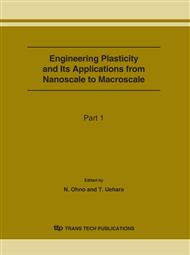p.1181
p.1187
p.1193
p.1199
p.1205
p.1211
p.1217
p.1223
p.1231
Deformation Behavior of Shape-Control Plate Using NiTi Shape Memory Alloy Wire
Abstract:
This study deals with deformation behavior of a shape-control plate which consists of an aluminum alloy plate and a pre-strained NiTi shape memory alloy (SMA) wire. The shape-control plate exhibits reciprocating bending deformation by heating and cooling. Deformation behavior of the plate is examined by electric heating and natural cooling of the SMA wire. Experimental results exhibit that the bending deformation of the plate is considerably stable over more than two thousand heating-cooling cycles and can be well controlled by electric current. Furthermore, the deformation behavior of the plate is analyzed by a simple beam theory for the aluminum alloy plate and Brinson’s one-dimensional constitutive model for the SMA wire taking account of not only martensitic transformation but also rhombohedral-phase transformation. Numerical results describe well the deformation behavior of the shape-control plate observed in the experiments.
Info:
Periodical:
Pages:
1205-1210
Citation:
Online since:
June 2007
Authors:
Price:
Сopyright:
© 2007 Trans Tech Publications Ltd. All Rights Reserved
Share:
Citation:


